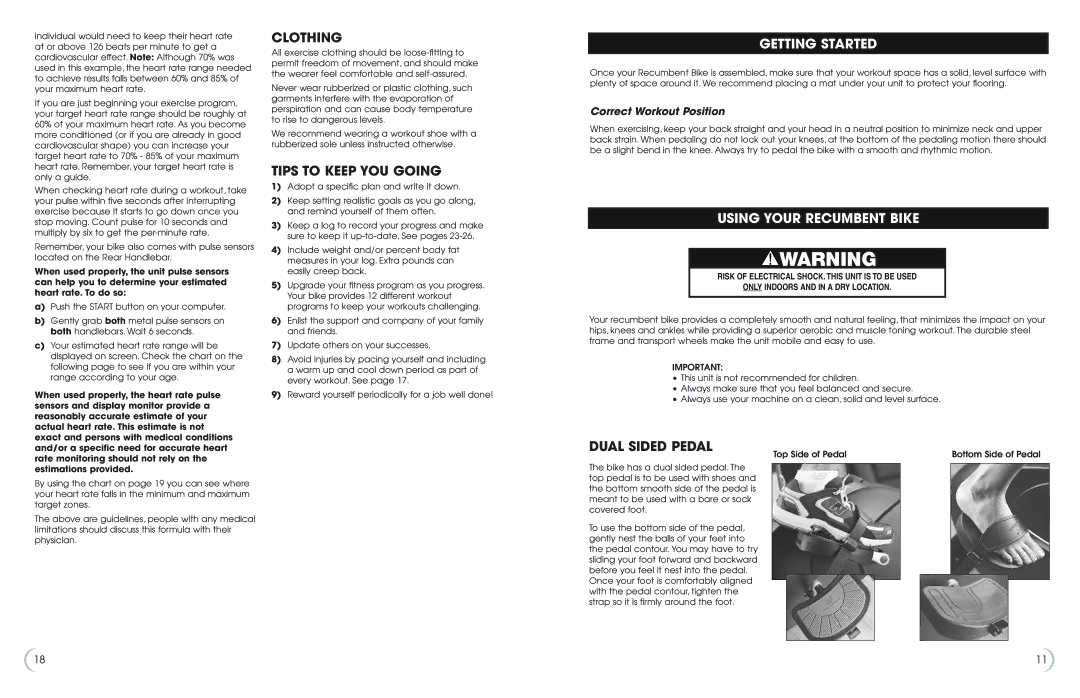
individual would need to keep their heart rate at or above 126 beats per minute to get a cardiovascular effect. Note: Although 70% was used in this example, the heart rate range needed to achieve results falls between 60% and 85% of your maximum heart rate.
If you are just beginning your exercise program, your target heart rate range should be roughly at 60% of your maximum heart rate. As you become more conditioned (or if you are already in good cardiovascular shape) you can increase your target heart rate to 70% - 85% of your maximum heart rate. Remember, your target heart rate is only a guide.
When checking heart rate during a workout, take your pulse within five seconds after interrupting exercise because it starts to go down once you stop moving. Count pulse for 10 seconds and multiply by six to get the
Remember, your bike also comes with pulse sensors located on the Rear Handlebar.
When used properly, the unit pulse sensors can help you to determine your estimated heart rate. To do so:
a)Push the START button on your computer.
b)Gently grab both metal pulse sensors on both handlebars. Wait 6 seconds.
c)Your estimated heart rate range will be displayed on screen. Check the chart on the following page to see if you are within your range according to your age.
When used properly, the heart rate pulse sensors and display monitor provide a reasonably accurate estimate of your actual heart rate. This estimate is not exact and persons with medical conditions and/or a specific need for accurate heart rate monitoring should not rely on the estimations provided.
By using the chart on page 19 you can see where your heart rate falls in the minimum and maximum target zones.
The above are guidelines, people with any medical limitations should discuss this formula with their physician.
CLOTHING
All exercise clothing should be
Never wear rubberized or plastic clothing, such garments interfere with the evaporation of perspiration and can cause body temperature to rise to dangerous levels.
We recommend wearing a workout shoe with a rubberized sole unless instructed otherwise.
TIPS TO KEEP YOU GOING
1)Adopt a specific plan and write it down.
2)Keep setting realistic goals as you go along, and remind yourself of them often.
3)Keep a log to record your progress and make sure to keep it
4)Include weight and/or percent body fat measures in your log. Extra pounds can easily creep back.
5)Upgrade your fitness program as you progress. Your bike provides 12 different workout programs to keep your workouts challenging.
6)Enlist the support and company of your family and friends.
7)Update others on your successes.
8)Avoid injuries by pacing yourself and including a warm up and cool down period as part of every workout. See page 17.
9)Reward yourself periodically for a job well done!
GETTING STARTED
Once your Recumbent Bike is assembled, make sure that your workout space has a solid, level surface with plenty of space around it. We recommend placing a mat under your unit to protect your flooring.
Correct Workout Position
When exercising, keep your back straight and your head in a neutral position to minimize neck and upper back strain. When pedaling do not lock out your knees, at the bottom of the pedaling motion there should be a slight bend in the knee. Always try to pedal the bike with a smooth and rhythmic motion.
USING YOUR RECUMBENT BIKE
![]() WARNING
WARNING
RISK OF ELECTRICAL SHOCK. THIS UNIT IS TO BE USED
ONLY INDOORS AND IN A DRY LOCATION.
Your recumbent bike provides a completely smooth and natural feeling, that minimizes the impact on your hips, knees and ankles while providing a superior aerobic and muscle toning workout. The durable steel frame and transport wheels make the unit mobile and easy to use.
IMPORTANT:
•This unit is not recommended for children.
•Always make sure that you feel balanced and secure.
•Always use your machine on a clean, solid and level surface.
DUAL SIDED PEDAL | Bottom Side of Pedal |
Top Side of Pedal |
The bike has a dual sided pedal. The top pedal is to be used with shoes and the bottom smooth side of the pedal is meant to be used with a bare or sock covered foot.
To use the bottom side of the pedal, gently nest the balls of your feet into the pedal contour. You may have to try sliding your foot forward and backward before you feel it nest into the pedal. Once your foot is comfortably aligned with the pedal contour, tighten the strap so it is firmly around the foot.
18 | 11 |
